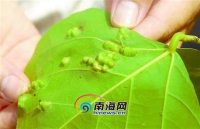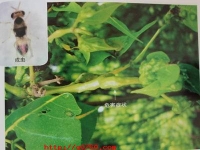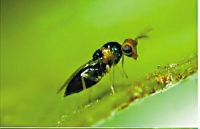 刺桐姬小蜂 刺桐姬小蜂 刺桐姬小蜂 刺桐姬小蜂 刺桐姬小蜂 刺桐姬小蜂 刺桐姬小蜂 刺桐姬小蜂 刺桐姬小蜂 刺桐姬小蜂
刺桐姬小蜂目前主要分布于毛里求斯、留尼汪、美国夏威夷、新加坡和我国台湾等国家和地区,台湾南部2003年发现后,现已传遍全岛,造成台南和台东地区刺桐大量死亡。
刺桐姬小蜂是2004年定名的新种害虫,在我国大陆是新记录,在我国台湾被认为是继红火蚁之后的又一重大外来有害生物。有关专家分析认为,刺桐姬小蜂在我国的发生至少有2-3年的时间。近年来在新栽植的植株上发生和危害严重,主要发生在城区和近郊。
刺桐属植物在我国有着悠久的栽培历史,是我国优良的乡土树种和重要的药用植物。近年来,我国广东等一些省份从境外大量引进了一些能开花的刺桐属植物,用于园林绿化。调查发现,刺桐姬小蜂主要危害引进植株。
分类地位:刺桐姬小蜂属于姬小蜂科eulophidae、啮小蜂亚科tetrastichinae、胯姬小蜂属quadrastichus。
寄 主:据报道,刺桐姬小蜂仅为害刺桐属植物,如刺桐erythrinaindica、杂色刺桐e.variegata、金脉刺桐e.variegata var.orientalis、珊瑚刺桐e.coralloides、鸡冠刺桐e.cristagalli、e.fusca、e.sandwicensis。根据初步调查,在深圳市种植的杂色刺桐、鸡冠刺桐、龙牙花e.corallodendron和金脉刺桐等四种刺桐属植物上发现该虫。
危害症状:刺桐姬小蜂严重为害刺桐属植物,造成叶片、嫩枝等处出现畸形、肿大、坏死、虫瘿,严重时引起植物大量落叶、植株死亡。
形态特征,雌成虫体较雄成虫大,体长1.45-1.60mm,黑褐色,间有黄色斑。单眼3个,红色,略呈三角形排列。复眼棕红色,近圆形。触角浅棕色,柄节柱状,高超过头顶;梗节长约为宽的1.3-1.6倍;环状节1节:索节3节,各节大小相等,侧面观每节具1-2根长与索节相近的感觉器,每根感觉器与下一索节相接:棒节3节,较索节粗,长度与2、3索节之和相等,第1棒节长宽相当,第2棒节横宽,第3棒节收缩成圆锥状,末端具1乳头状突。前胸背板黑褐色,有3—5根短刚毛,中间具一凹形浅黄色横斑。小盾片棕黄色,具2对刚毛,少数3对,中间有2条浅黄色纵线。翅无色透明,翅面纤毛黑褐色,翅脉褐色,亚前缘带基部到中部具刚毛1根,翅室无刚毛,后缘脉几乎退化,前缘脉:痣脉:后缘脉:3.9—4.1:2.8—3.1:0.1—0.3。腹部背面第一节浅黄色,第二节浅黄色斑从两侧斜向中线,止于第四节。前、后足基节黄色,中足基节浅白色,腿节棕色。
雄成虫体长1.0—1.15mm,头和触角浅黄白色,头部具3个红色单眼,略呈三角形排列。复眼棕红色,近圆形。触角柄节柱状,高超过头顶;梗节长约为宽的1.5倍;索节4节,第1节小于其它各节,无轮生刚毛;棒节3节,较索节粗,长度与2、3索节之和相等,第1棒节长宽相当,第2棒节横宽,第3棒节收缩成圆锥状,末端具1乳头状突。前胸背板中部有浅黄白色斑。小盾片浅黄色,中间有2条浅黄白色纵线。腹部上半部浅黄色,背面第一、二节浅黄白色。足全部黄白色,
生物学特性:根据目前的研究结果,该虫繁殖能力强,成虫羽化不久即能交配,雌虫产卵前先用产卵器刺破寄主表皮,将卵产于寄主新叶、叶柄、嫩枝或幼芽表皮组织内,幼虫孵出后取食叶肉组织,叶片上大多数虫瘿内只有1头幼虫,少数虫瘿内有2头幼虫:茎、叶柄和新枝组织内幼虫数量可达5头以上。幼虫在虫瘿内完成发育并在其内化蛹,成虫从羽化孔内爬出。该虫生活周期短,1个世代大约1个月左右,1年可发生多个世代,世代重叠严重。 |
|
|